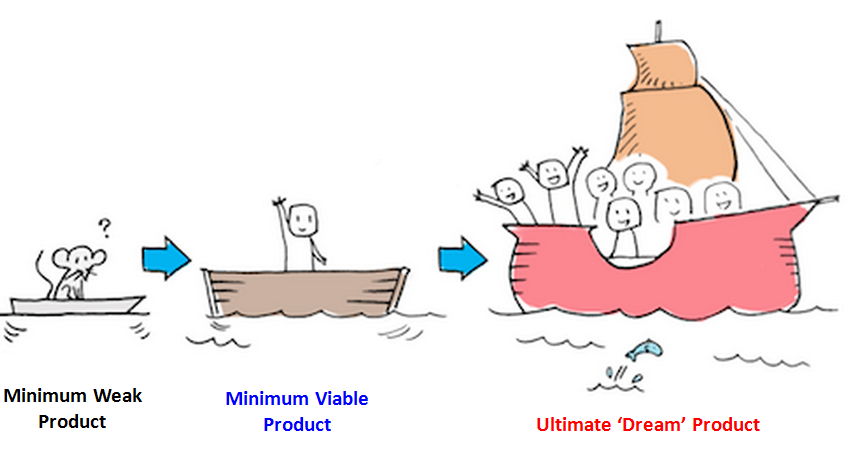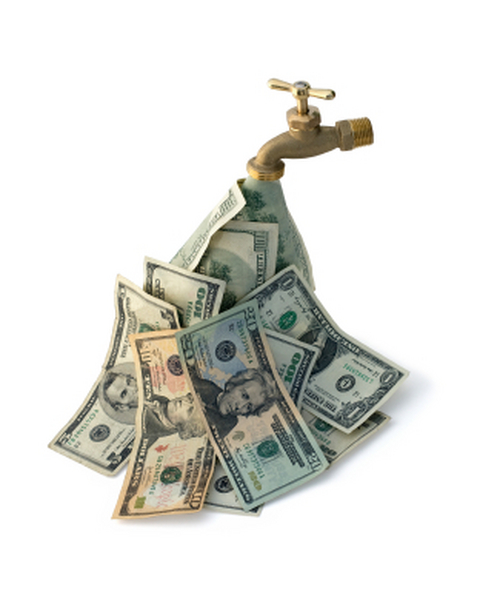Template: The 20 Minute, 1 Page Business Plan for App Startups
You’re reading Part 5 of the Buzinga crash course How To Build An App: Moving Forward With Your App Idea
Go to Part 1: The Startup’s Guide To Measuring Market Size For An App Idea
Go to Part 2: 5 Tips For Validating Your App Idea
Go to Part 3: How To Perform Competitive Analysis On Apps
Go to Part 4: How To Choose Your App Monetisation Model: 6 Key Questions
I’m a big advocate for having goals and a plan for building your startup hard and fast.
That’s why my one big criticism of the business plan is it’s too long, and a lot of it is unnecessary and rigid.
So, one of the first things I tell my clients to do after they’ve validated their app idea is to write a lean canvas, sometimes called a 1 page business plan.
A 1 page business plan is an adaptation of the business model canvas, borrowing best practices of the Lean Startup Methodology.
This plan eliminates wasted resources by focusing on problems, solutions, key metrics and competitive advantages.
It essentially serves to get you to start thinking about all commercial aspects of your new business in the same way a thoroughly researched, 30+ page document would!
This post will give you a printable template to create a 1 page business plan for app startups, and run you through how to fill out each 9 sections.
Why do it?
- It forces a startup to start thinking about their app as more than just an idea
- Highlights any risks that may have been overlooked in the ideation phase
- Highlights any potential areas where you may encounter problems
- Ensures that every major section of importance has been acknowledged
How long will it take?
It shouldn’t take longer than 20 minutes to complete a lean canvas.
It isn’t meant to be perfect – the aim is just to cover all bases on a simplified level, so you should just try to get something down on paper.
Click here to download your printable lean canvas
1. Customer Segments
The easiest way to build an app that engages its users is to know who those users are in the first place.
Then, you can build your product around their needs and their behaviours.
It’s important to recognize that listing out your customer segments is purely guess work at this early stage.
You will need to dig down and spend some time researching these people further once you launch your product, but for now try and be as specific as you can when you are listing your customer segments.
The easiest and most thorough method of segmentation uses demographics and psychographics.
- Demographics – Statistical, population-based characteristics
- age
- gender
- occupation
- marital status
- Geographic location
- Household income (this is helpful to know when setting your monetisation strategy)
For example: Fathers aged 30-55 who live in outer-city suburbs and earn $70K-$100K a year.
Now that you’ve identified your market on a superficial level, look at their psychographics.
Your customer is more than a bunch of numbers. Not every father aged 30-55 who is experiencing the problem your app attempts to solve will be engaged by your product.
Why? Because consumer behaviour is driven by inner desires and attitudes, and these are unique to all of us!
2. Psychographics – Characteristics of a customer based on interests, activities and opinions.
Setting out psychographics basically sets a profile of your customer’s lifestyles.
Here’s a practical example of psychographics that could stem from your demographics, from Hubspot’s Marketing Blog.
- Concerned with health and appearance
- Wants a healthy lifestyle, but doesn’t have much time
- Enjoys going online in the evenings
- Tends to favor quality over economy
- Finds fulfillment in his career and family
- Values time with a small group of friends
Wherever you can, dig deeper into your customer’s profile.
For example, if you’ve identified your customer is a runner as one of their psychographics, what kind of runner are they?
Do they compulsively run every day, or just once or twice a week?
What’s their motivation for running? Is it to lose weight or just to keep up a basic level of fitness?
You will probably identify several customer segments at first. That’s totally fine!
Whack them all in there and just go through them later in the development phase.
You’ll have a clearer idea of which segments are most profitable by then, and you can target them appropriately.
2. Problem
Some people like to begin with the problem first, but I believe that starting by identifying your customer is more beneficial.
This way, you are already in your customer’s head and can explore their specific needs based on problems they are having in their unique lifestyles.
First of all: A problem is only a problem if someone is experiencing pain because of it.
In this section, you need to address the following points:
- What is the pain point that your customer segment(s) is experiencing?
- How does your app solve that problem and make their life easier?
- How is the problem currently being solved?
That last point is an important one. What alternative methods are your customers using at the moment to meet their need?
This will usually manifest itself in one of two ways:
- Competitors’ product
- A DIY solution or otherwise ineffective method
For example, before DropBox gave office workers a common space to upload their own files and have access to other people’s, people were simply emailing each other links and files.
There will likely be several specific problems your app solves, but limit it to the 3 most important for each customer segment for now.
3. Solution
So now that we know who our ideal customer is and the problem they have that we can fill, we need to tailor the solution.
This section is essentially outlining what we call your Minimum Viable Product (MVP).
This is the product you can deliver with the highest return on investment versus risk – no bells and whistles at this stage.
Again, it’s an integral component of the Lean Methodology that this canvas applies!
So how do you write this section?
It doesn’t suffice to simply give customers your solution the way you imagine it. You need to get inside their heads to understand:
How they want the solution
- What does it need to look/feel like?
- How do we need to act and what do we need to say/do in order to earn their trust?
How they want the solution to work
- What is their natural thought process?
- What will make sense to them?
When they want the solution
- What time/place is most convenient and natural for them to adopt our solution?
You can put key features in this section too, if they are integral to your app’s core functioning.
There should be no more than 4-5 features in this section. Any more and you risk confusing the user with version 1.
Recommended reading: Why more features aren’t the answer to slow app growth
4. Unique Selling Proposition
Your USP is a short statement (1-2 sentences) that tells customers why your app is so special.
“A USP is not merely a slogan — it is your company’s DNA and reason for being. If you cannot summarize exactly what sets you apart in one or two sentences, you are not unique enough within your marketplace.” – Perry Marshall, Marketing Consultant
The reason why it’s important to start forming your USP now is because it can help you decide if a potential new app is different from what is already available.
The USP also helps determine whether there is any reason for a customer to actually use the app instead of continuing to use established competitors’ apps or their own DIY methods.
Lack of a strong differentiating characteristic means your app isn’t likely to thrive.
The market is just too saturated for anyone to throw out a ‘me too’ product and hope it sticks.
If there is a strong differentiator, however, the venture has a good chance of being successful.
The USP is difficult to nail down, and they often change as a business matures and expands to different services and customer segments.
Here are some tips to get you started:
- Focus on the benefits, not the solutions. How does it uniquely address the problem your segment is experiencing?
- Why should a customer do business with you instead of anyone else?
- What can your product or service do for me that others can’t?
- What can you guarantee me that no one else can guarantee?
5. Marketing and communication channels
Investing thousands of dollars into app development and just hoping that people will download it once you’ve launched to the app store WILL NOT WORK.
Why?
Because no one will know your app exists!
Customer acquisition (in other words, actually getting people to start using your app) was the most reported challenge for startups in 2014.
Recommended reading: 5 Customer Acquisition Strategies To Reel In Your First 5,000 App Users
My best guess for why this is such a problem is that many startups don’t know how to make a lot of noise with a limited budget.
They either don’t ‘do’ marketing at all, or they spend their money in the wrong places that have little impact.
A good place to start is by identifying where your ideal customers are already hanging out online, what they are reading, and where they are currently going to solve the problem that your app solves.
Then, focus on building a presence in those channels.
Here are some low cost channels you can leverage to get the word out about your app, but really, the sky is the limit!
- PR – press releases, app reviews, news stories
- Email marketing – collecting emails to build your database and nurturing them with relevant and interesting content
- Social media – Facebook, LinkedIn, Twitter, Instagram, Pinterest, Google+ (just kidding, who uses Google+…)
- Going to events, seminars or parties that your customer segments often go and getting the word out.
- Paid in-app advertising
Recommended reading: App Marketing Guide: How To Build Your Brand Online
6. Revenue Streams
How will your app make money?
Pricing structure is a tough thing for startups to address early in the development process.
Don’t worry too much if you don’t have much of an idea just yet – monetisation strategies for even big-brand apps are constantly being adjusted as their businesses mature.
Many apps are released for free when they first launch, focusing on user growth first and revenue later.
Pinterest is the most famous example of this – The social platform raised its $762 million in venture capital before it made even a cent, and has only recently rolled out its revenue model, Promoted Pins, 4 years after its launch!
That being said, Pinterest was spending this time collecting valuable user data to optimise their revenue model.
Make no mistake, they were definitely thinking about money when they launched!
Moral of the story: Don’t become complacent about how important your monetisation strategy is, even this early in your startup journey.
You should develop your app with the entire business in the back of your mind.
There are hundreds of monetisation models out there, and many apps choose a combination of a few for best effects.
Let me just say now, PAID APPS ARE DEAD.
By 2017, 94.5% of downloads will be for free apps – Gartner, 2014
Instead, here are some of the most popular and effective monetisation methods apps are using in 2015:
1. Free, but with in-app advertising (Eg: Facebook, Youtube)
This monetisation model aims to accumulate a large user base and gather data on the users interacting with your app.
It removes the cost barrier and allows for free downloads.
This works extremely well if your app’s a new concept to the market.
Pros
- Everyone loves getting something for free – quickly acquire plenty of new users.
- This model’s effective if minimal and targeted advertising is used.
- Puts your app in a great position to collect data such as in-app behavior of your users.
Cons
- People can get annoyed with advertisements leading to user drop off.
- User experience can be greatly compromised.
- This model won’t work for utility apps that help users perform specific actions (Think banking apps or city transport apps). Ads in these apps make the user experience feel unnatural and intrusive.
2. Freemium – Eg: Spotify, LinkedIn, Evernote
Freemium describes products that are free to use, but contain locked features customers can pay for if they want.
Pros
- Users who try before they buy are more likely to become engaged and buy down the track – Usually when they find they can’t do without your app!
- This models allows you to develop a large user base with the view of up-selling down the track
Cons
- If you don’t offer enough features for free, your users may drop off.
- On the other hand, if you offer too many features for free, no one will want to upgrade.
- You must be careful that the free features of your app don’t lead to a poor user experience.
3. Sponsorship (Incentivised advertising) – Eg: Runkeeper, Menulog
Sponsorship is one of the newest entrants into the mobile app marketplace.
Sponsorship is where you partner with advertisers who’ll provide your users with rewards for completing certain in-app actions.
This model allows brands and agencies to be part of an incentive system.
Your app earns money by taking a share of the revenue from the redeemed rewards.
This incorporates advertising that actually enhances your app’s ability to engage users.
Pros
- Everyone’s a winner – You will gain more revenue. Users get the benefit of free promos. Advertisers get more ad space.
- This monetisation strategy will be better received by your users. This is because it won’t compromise their experience in your app.
- This strategy can be adopted on many different levels.
Cons
- This strategy hasn’t been as thoroughly tested as more common models.
- Mobile marketers need to be cautious about what actions they incentivise in their app.
4. In-app purchases – Eg: Candy Crush, Tinder, Snapchat
This app monetisation strategy involves selling virtual or physical goods through your app. The best part is you retain all the profits.
Purchases made through your app can include products like clothing and movies etc.
In-app purchases can also be virtual goods such as in-game currency.
Pros
- Works well with e-commerce brands.
- Buying virtual goods leads can lead to greater user engagement
- Can help app developers make a comfortable profit with minimal risk.
Cons
- This model has received some bad publicity. This is due to children unknowingly making in-app purchases using their parents accounts.
- The app stores will take a percentage cut of the profits for virtual goods.
- Users may be less inclined to download your app if they see that it includes in-app downloads.
5. Subscriptions – Eg: Whatsapp, Apple Music, Netflix
A subscription provides a guarantee of repeat transactions. The subscription price is usually smaller than the one-time price to incentivise the user into a longer term commitment.
As the seller, you make up for the discount by guaranteeing future transactions.
Subscriptions allow an app user to view a certain amount of content for free.
The user’s then prompted sign up for a paid subscription to get more. Service-focused apps will benefit most from this strategy.
Pros
- Leads to loyal and engaged app users.
- Results in a continual weekly/monthly/yearly revenue stream.
- The subscription model encourages writers to constantly deliver valuable content. If the content is consistent then you’re likely to retain subscribers.
Cons
- Doesn’t easily translate to all app types. More suited towards service apps.
- It can be hard to determine just how much content to provide for free and where to start charging.
Many of these app examples use a combination of multiple monetisation methods, which is also a great way to earn more revenue.
7. Cost structure
It’s always worthwhile to be thinking about the costs you’ll be racking up when planning your business.
Have a look at this financial planning template for app startups. It’s a customization spreadsheet that’ll help you forecast your profit and loss for the next 3 years.
These numbers can be pretty high level, and of course they’re flexible.
Just start thinking about ball park figures for your costs, how frequent they will be (monthly, annually, etc), and when you estimate your break even point will be.
8. Key Metrics
We’re living in an age of big data. Everyone is collecting it, but most people don’t know how to understand it.
Because every app is different, the key metrics that signify your app’s success vary for every app.
The big 5 metric types include:
- Acquisition metrics
- Retention Metrics
- Behavioural metrics
- Engagement metrics
- Quality metrics
For more detail on how to use these metrics, head over to this infographic.
Identify your app’s main goal and pick 3-4 metrics that will be most important for reaching that goal.
These goals will also depend on your app’s industry/vertical. Not all apps want the same kind of in-app activities.
It doesn’t make much sense to use an unrelated industry’s metrics as the bible for what you should be measuring.
For example:
- Publishing apps typically want greater content consumption – engagement is a key focus for them, and therefore their metric focus would be increasing session time.
- Dating/social apps typically want social interaction – acquisition metrics may be a focus for them so they can increase their database and offer existing users more value, creating a network effect.
- e-Commerce apps want sales – their focus may be on converting casual browsers into actual purchasers.
Don’t focus on vanity metrics like number of downloads or number of likes on Facebook – these don’t drive action and aren’t really indicative of how valuable your app is to users.
Recommended Reading: How To Use Data To Drive App Insights (The Uber Way)
9. Unfair Advantage
This will be the hardest section to fill out, because it may be too early to nail down what will make your app have staying power.
Intellectual Property is dead, and the app market is more competitive than it has ever been.
How is your app going to compete in its industry, and how will its advantage be sustainable?
By that, I mean what will protect it from being copied, imitated, or someone making something of better quality?
Tip: Being first to market or having the lowest price is NOT an unfair advantage.
Brand loyalty, exclusive contracts/supply relationships, endorsements, and distribution channels are examples of things that CAN be an unfair advantage.
Branding particularly is one of the most powerful assets a product can have.
It’s what makes people buy their preferred brand of milk over the cheaper $1 a litre Coles brand. It’s what makes Apple die-hards line up for hours for the newest iPhone.
How can you make your product more than just a bunch of features, that will turn your users into screaming evangelists and high-value, addicted fans?
Recommending Reading: 10 Steps To Branding Your App
Wrapping up
Many businesses will revisit and rewrite their business plans multiple times over their lifetime – to update their business model, positioning or otherwise.
This flexibility is the whole point of the 1 page business plan, so don’t be afraid to use it again and again!
Print it out, grab a glass of wine and power out the handwriting.
Where to go next
The Information Memorandum Investors Actually Want To Read
The Ultimate Guide To Pitching Your App To Investors
The Essential Financial Planning Template For Your App Startup
Infographic: How To Raise Funds For Your Startup
<!– / OptinMonster ?
Latest posts by Logan Merrick (see all)
- Ep 18: Collective Campus’ CEO on Intrapreneurship and Corporate Innovation - December 20, 2016
- 50 User Engagement Strategies For Planning Memorable Mobile Experiences - December 19, 2016
- Latest Data: App Monetisation Trends And Drivers 2015-2020 - November 25, 2016












